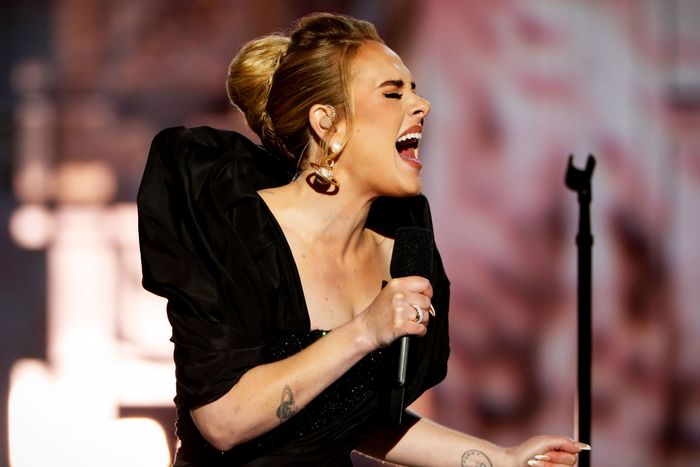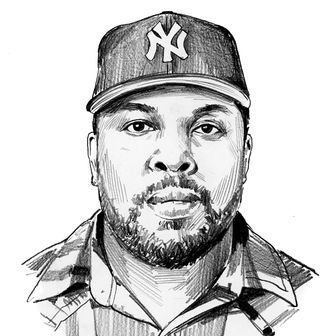
Adele is a volcano, stewing in secret for years until the moment she cuts loose and melts everything in her path. Her studio albums — 19, 21, 25, and the new 30 — are snapshots of unique junctures in her personal life. Like British director Michael Apted’s Up documentary series, which has checked in on the lives of a string of subjects at seven-year intervals since the 1960s, the London-born singer lets us in every few years to share what she’s learned about love and loss and creativity and art. On 19, Adele arrived amid a new wave of U.K. soul revivalists, successful artists like Duffy and Amy Winehouse who, at that moment, were being touted as a kind of new British invasion. Adele’s soulful, cinematic “Chasing Pavements” was a hit on both sides of the Atlantic, this after the maudlin ballad “Hometown Glory” fared decently on European charts.
But we lost Amy to tragedy, and Duffy (whose 2008 debut Rockferry beat out Coldplay’s Viva la Vida and Radiohead’s In Rainbows for top honors at the 2009 Brit Awards, where Adele was nominated three times but shut out, marking the last time she left that show empty-handed), began an indefinite hiatus in 2011 that she hasn’t come back from. Adele, who gigged with “Thamesbeat” acts like Jamie T and Jack Peñate and whose debut album carried a whiff of the Thames scene bands’ wholesome genre-bending, particularly in songs like “Right As Rain” and “Cold Shoulder,” filled the void. Her next album, 2011’s 21, leaned into qualities that guided the last album’s singles to acclaim. 21 made more room for pop gestures like “Set Fire to the Rain,” “Rolling in the Deep,” and “Rumour Has It,” calling in successful pop-rock engineers like Rick Rubin, Ryan Tedder, and Paul Epworth to produce, where 19 had gone to rock engineer Jim Abbiss (Arctic Monkeys, Kasabian, Peñate) and Mark Ronson for ideas.
The passage from 19 to 25 is a series of breakthroughs in which Adele releases songs that elevate her to new levels of esteem, then the sound of the hits prevails on the next record. 19’s “Hometown Glory” did well; 21 centered stormy piano pop. The plodding-forward push of 21’s “Set Fire to the Rain” telegraphs 25, a work too full of that kind of song. 25 was a juggernaut, an adult-contemporary blockbuster that set about appealing to the masses by sanding all of its rough edges down, leaving little else but the vocalist and whatever sleek and saccharine sounds drove the chorus home. It is a deeply affecting record and an intermittently middle-of-the-road one, a line drive straight toward the shared tastes of the millions it stood to reach. The lead single, “Hello,” flows toward a loud finish like flood waters wreaking havoc after a dam breaks. Adele’s voice is elemental, pliable with perfect pitch, devastating everywhere between a low whisper and a yelp, as 25’s gutting ballad “Remedy” bears out. But it was a mistake not to have the music push back and challenge her much. When the arrangements pick up a bit of speed and intrigue, as they do in “Water Under the Bridge” and “Send My Love (To Your New Lover),” she responds in kind, skipping delightfully across the track. Leaving upbeat tunes like “Right As Rain” and “I’ll Be Waiting” behind in favor of torch songs like “Hello” and “When We Were Young” narrowed the creative breadth of Adele’s albums, a streamlining that succeeded beyond anyone’s wildest dreams. 25 sold millions worldwide in a week, but now, fame was a cage. The singer recalled the response to “Hello” in a recent Vogue profile: “I don’t want another song like that. That song catapulted me … to another level that I don’t want to happen again.”
This time around, “Send My Love” is the epiphany lighting the way to a new era. That single’s methodical build and slowly evolving groove are mirrored in the highlights of 30, the long-awaited follow-up to 25 and a chronicle of the turbulence in the wake of the end of the star’s marriage. In 2019, the singer left Simon Konecki, the entrepreneur she met in 2011 and wed in 2018. Now divorced, the two live on opposite sides of the same street to smooth joint-parenting of their 9-year-old son, Angelo. 30 wears the grace of that arrangement on its sleeves. The ex here doesn’t catch a tenth of the hell the ex from 21 did, though when 30 does cut loose, it nearly scorches the earth. Instead, these songs are concerned with the betterment of Adele as a musician, a mother, and a woman. She’s sharpening her writing and pushing her voice. She’s working with more challenging compositions. 30 is breaking up with the placid tastefulness of the records Adele released in her 20s, in a sense. The new songs start in familiar scenarios, sneaking in quietly with a skeletal piano melody, as “Hold On” does, and building to a powerful gospel chorus, or juggling Motown soul and reggae, like “Cry Your Heart Out,” which takes after Stevie Wonder’s “Master Blaster (Jammin’).”
There’s a sly balancing act happening here: Adele reconciles her romantic past and present and opens new sonic avenues in her music without abandoning the last two albums’ lucrative deference to classic ’70s singer-songwriter pop. 30’s “Oh My God” gestures to Afrobeat between rock-oriented verses and a dance-pop chorus. The Max Martin and Shellback collab “Can I Get It” is a hodgepodge of jarring ideas, alternately conjuring Oasis’s “Wonderwall,” George Michael’s “Faith,” and Aloe Blacc’s “I Need a Dollar.” It’s here that 30 starts to feel like it’s trying a little too hard, like there is a market-tested intelligence to the bases it touches in its production, though, to its credit, a useful side effect of that care is that this album comes across more like someone letting us ogle their extensive record collection and less like the sound of cultures being glommed onto. 30 treads into R&B in “My Little Love” and “Woman Like Me,” but “Hold On” and “I Drink Wine” pull the listener elsewhere, into rootsy pop-rock. The strings and showy vibrato of “Strangers by Nature” give off acute Judy Garland feels. (In certain cuts — like “All Night Parking,” where Adele sings over samples of late jazz pianist Errol Garner outfitted with trap drums, and this works so well you wish the album took bigger swings — 30 feels like a knowing tribute to the slippery, intergenerational soul of Amy Winehouse’s Back to Black. Is our closer “Love Is a Game” a nod to Back’s “Love Is a Losing Game”? Are the smoky tones and jazzy delivery in “Parking”? Or did they both stan Dinah Washington?)
As producers like Martin, Greg Kurstin (Beck, Sia, Foo Fighters), and Inflo (Sault, Little Simz) hammer out a livelier palette of sonics, Adele rises fitfully to the task, revealing impressive command of her instrument as she affects the chipper, lilting notes of old-time jingles (“Cry Your Heart Out”); plays enticing tricks with her volume (“To Be Loved”), vibrato (“Hold On”), and falsetto (“Easy on Me”); shares diaristic private voice notes (“My Little Love”); and dabbles delightfully in vocal manipulation (“Oh My God”). She learned a little something with every release. 30 sometimes calls back to the experimentation Adele explored as she and the London Thamesbeat acts of the late ’00s chipped away at the barriers between pop and indie rock in the 19 era. It processes hurt via soul-searching and withering emotional directness, as 21 did, and relies on the brute force of the singer’s instrument to sell us on the messages in the lyrics, the same way 25 did. What’s new now is that she’s asking different questions, not settling for reading a bad boyfriend for filth or walking through the complicated dissolution of a relationship that seemed built to last. Outside of the fury of “Woman Like Me” — “I don’t think you quite understand / Who you have on your hands / How can you not see / Just how good for you I am” — 30 wants self-sufficiency. “Why am I obsessing about the things I can’t control?” Adele asks in “I Drink Wine.” “Why am I seeking approval from people I don’t even know?”
By the end of the album, on “Love Is a Game,” a mix of Philly-soul brass and girl-group vocal harmonies, Adele has sworn off romance entirely: “Love is a game for fools to play / And I ain’t fooling / What a cruel thing / To self-inflict that pain.” Disappointment is tiring. “To be loved and love at the highest count,” as the chorus of the breathtaking late-album scorcher “To Be Loved” goes, “means to lose all the things I can’t live without.” It’s a sentiment you can only arrive at after having made the trip around the sun a few times, having failed and been failed enough to know your limits and get militant about preserving your time, honor, and energy. Songs written about the intersection between our 20s and 30s, like Danny Brown’s “30” or Bo Burnham’s “30,” often touch on the dread of reaching the point where we are tacitly expected to have figured ourselves out, being written amid the mid-grade panic of 29. Adele’s 30 is less interested in this fear than in the steps we can take to abate it. The lyrics see Adele tracing a path to emotional wellness. The music is seeking fresh approaches to her craft. Her songs are getting looser, more conversant in global trends. 30 is where she realizes that she doesn’t have to always pitch us slow, sad, jilted tunes to stay in the game. This is still every bit the savvy act of demographic outreach the old records were. It’s just better. 30 is the best Adele album. If it sells less than 25, so what. This is the music she should’ve been making all along.


